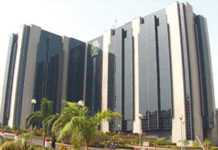When the Central Bank of Nigeria (CBN) went to town with the story of N8 billion fraud involving some of its staff last week, the news did not shock the public.
The CBN said a nationwide audit of all its 37 branches last year, following allegation of currency fraud and re-circulation of defaced and mutilated currencies, exposed a mega scam that had been on for several years.

A statement issued by CBN Director of Corporate Communications, Ibrahim Mu’azu, detailed how workers swapped lower denomination currencies meant for destruction with higher currencies, a practice known as interleafing.
In other words, the suspects swapped notes originally meant for destruction with lower denomination currencies, and diverted same to their personal use.
A panel comprising senior staff from different branches noticed this anomaly at the Ibadan branch during a routine internal audit in September 2014.
CBN Governor, Godwin Emefiele, and the banking industry swung into action and confirmed the suspicion that fraud had been perpetrated.
“As soon as the bank’s internal investigations were concluded beyond reasonable doubt that some wrongdoing had occurred, the affected members of staff who are middle-level officers, depending on the gravity of the offence, were either summarily dismissed or immediately placed on indefinite suspension on October 21, 2014, and all handed over to the EFCC (Economic and Financial Crimes Commission) for further investigation and prosecution,” Mu’azu stated.
The EFCC has arraigned five top CBN executives implicated, raising hope that sanity will return to the banking system where common criminals take advantage of their privileged position to perpetrate crime.
Some 4,142 fraud related cases and refund of N14.7 billion excess charges to banks’ customers were recorded against greedy banks between 2010 and May 2014.
Records from the banking industry, once known for unassailable integrity, showed that Nigerian banks lost a total N159 billion to electronic fraud between 2000 and first quarter of 2013.
Nigerian Inter-bank Settlements Systems (NIBSS), Executive Director (Business Development), Christabel Onyejekwe, quoted e-fraud data compiled by the Financial Institutions Training Centre (FITC).
She said the figure stood at N1.65 billion in 2000; N3.12 billion (2001); N8.20 billion (2002), but declined to N5.13 billion in 2003 while in 2004, it rose to N89.43 billion.
E-fraud declined to N6.76 billion in 2005 and N2.74 billion in 2006 and went back up to N8.51 billion in 2007.
According to Onyejekwe, 2008 marked a watershed in the trend of e-fraud, as banks recorded the highest loss of N34.50 billion.
The successful switch from magnetic stripe of Automated Teller Machine (ATM) cards in 2009 to a more secure chip and PIN cards led to a drastic reduction in e-fraud to the tune of N21.72 billion with a further decline to N14.96 billion in 2010.
The figure increased again to N24.43 billion in 2011 and to N10.06 billion (2012) while in first quarter of 2013 alone, e-frauds were valued at N7.5 billion.
Onyejewe said these figures listed from 2000 to the first quarter of 2013 amount to about N159 billion losses in the system.
She, however, projected that for this year, if recorded fraud at the end of first quarter is N7.5 billion, “extrapolated expected fraud at the end of the year would be N7.5 billion multiplied by four and this will be N30 billion.”
In 2012 alone, banks recorded 3,380 fraud cases involving N17.97billion.
The Nigeria Deposit Insurance Corporation (NDIC) said of the figure, the contingent or expected loss was N4.52 billion, which increased by N455 million or 10 per cent against the N4.072billion reported in 2011.
The number of reported fraud cases rose 43.7 per cent from 2,352 in 2011 to 3,380 in 2012, but the amount involved decreased 36.4 per cent from N28.40 billion to N18.04billion.
The NDIC confirmed that banks reported 3,380 fraud cases involving N17.97 billion with expected/contingent loss of about N4.52 billion in 2012, which increased by N455 million (10.9 per cent) against N4.072 billion in 2011.
“Notwithstanding the 43.7 per cent increase in the number of reported fraud cases from 2,352 in 2011 to 3,380 in 2012, the amount involved decreased by 36.4 per cent from N28.40 billion in 2011 to N18.04 billion in 2012,” the NIDC explained.
The Nigerian Interbank Settlement Systems Electronic Funds Transfer (NISSEFT) disclosed that banks and mobile money vendors lost N6.2 billion to web and internet banking frauds in 2014 against N485 million in 2013.
It said transactions that passed through electronic channels of internet and web banking (e-money transactions) were so much exposed to fraud as internet accounted for the highest risk to its users, followed by web applications and ATM.
Investigation by TheNiche showed that the astronomical growth in e-crime last year was connected with the widespread vulnerability of websites known as the ‘Heartbleed’ bug which ran on the servers of millions of websites and compromised some websites between mid-2013 and April 2014.
The bug created a hole that allowed hackers to get in and around the secrete language on sites and made it possible for the secret information to be stolen.














